The Blue Whale is the biggest animal in the world. There is no other animal that can be identified as being larger than a Blue Whale.
How big is a blue whale?
The average length of adult blue whales is 79 ft (24.1 m). In fact, they’re the biggest to ever live. That means the biggest dinosaurs didn’t match the size of a Blue Whale.
These marine mammals are so big that a car like a Mini Cooper is similar in size to a blue whale heart, and their tongue alone can weigh more than a fully grown elephant!
Largest blue whale
The reported longest whale was 100 ft (30.5 m) in length.
However, a single blue whale was 98 ft (29.9 m) for the longest measured scientifically, from the rostrum to the tail notch.
Blue whale weight
On average, Antarctic males weigh 112 tonnes, and females weigh 130 tonnes.
If you are looking for information about some fun facts, below is a list of 10 facts about Blue Whales:
10. Hippos are closest living relative to whales
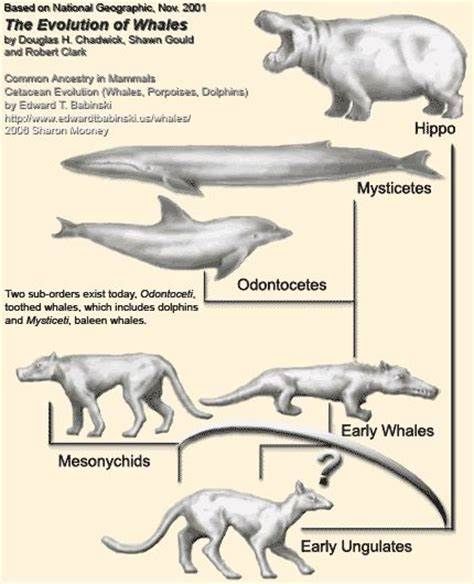
Modern genetic and fossil evidence shows that hippopotamuses are the closest living relatives of whales (Cetacea).
Although they look very different today, both groups descend from a common, now-extinct ancestor that lived roughly 55 million years ago.
That ancestor belonged to the even-toed hoofed mammals (Artiodactyla).
Fossil clues: The earliest whales (e.g., Pakicetus, Ambulocetus) were four-legged, wolf- or crocodile-sized animals that lived 50–48 million years ago.
Geography: The oldest proto-whale fossils come from Indo-Pakistan, not Asia-to-Africa migrants; hippos, however, do appear to have evolved in Africa from anthracotheres about 15 million years ago.
Africa was already intermittently connected to Eurasia by land bridges at that time.
9. Blue whales don’t sleep like us
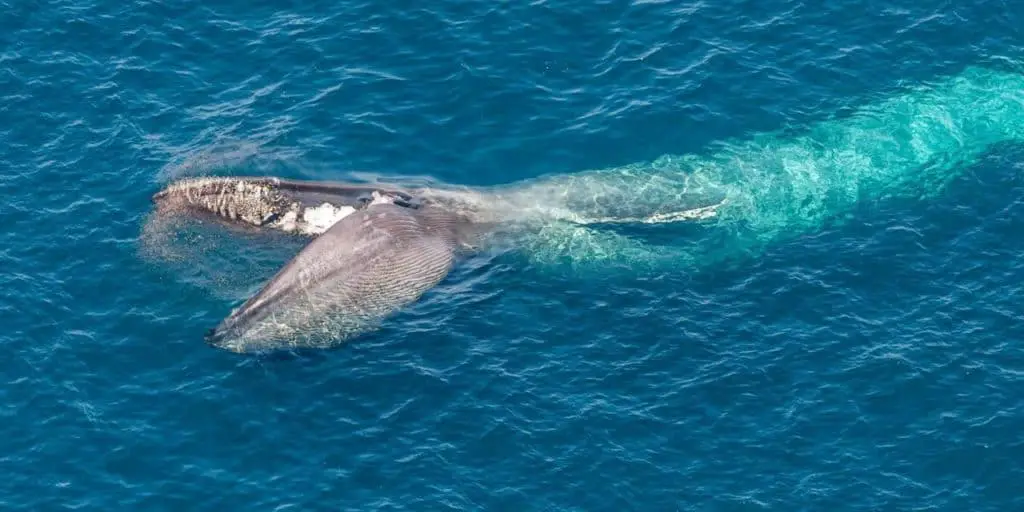
Blue whales, like all marine mammals, cannot sleep the way terrestrial mammals do.
Because they are voluntary breathers, they must consciously decide when to surface and open their blowhole; complete unconsciousness would cause them to drown.
To solve this, blue whales have evolved unihemispheric slow-wave sleep: one half of the brain rests while the other half stays awake to regulate breathing and watch for predators.
During these rest periods, they often “log,” which means they lie quietly at or just below the surface, looking like floating logs, sometimes side-by-side with another whale.
By contrast, sperm whales are famous for their vertical, head-down naps, drifting in short 10- to 15-minute bouts that make up only about 7% of their day.
8. Whale “vomit” is used to make perfumes & is very expensive

A Blue Whale’s diet comprises krill (Shrimp-like creatures), and it can eat up to 40 million krill per day.
But just like any warm-blooded mammal, it sometimes vomits.
Ambergris is marine excrement produced from the abdomen of whales that is thought to help digestion.
Discharged from the deep inner water away from the coast, it gets soft and rancid when vomited.
Years of saltwater and wind exposure turn it into something like a rock with a waxy texture and a pleasant smell.
A chunk of ambergris weighing 7 pounds can amount to more than $50,000.
It is extremely valuable not only because it is rare, but also because it is difficult to discover an artificial replacement for it as a perfume base.
7. All Marine mammals have nose like us (sort-of)
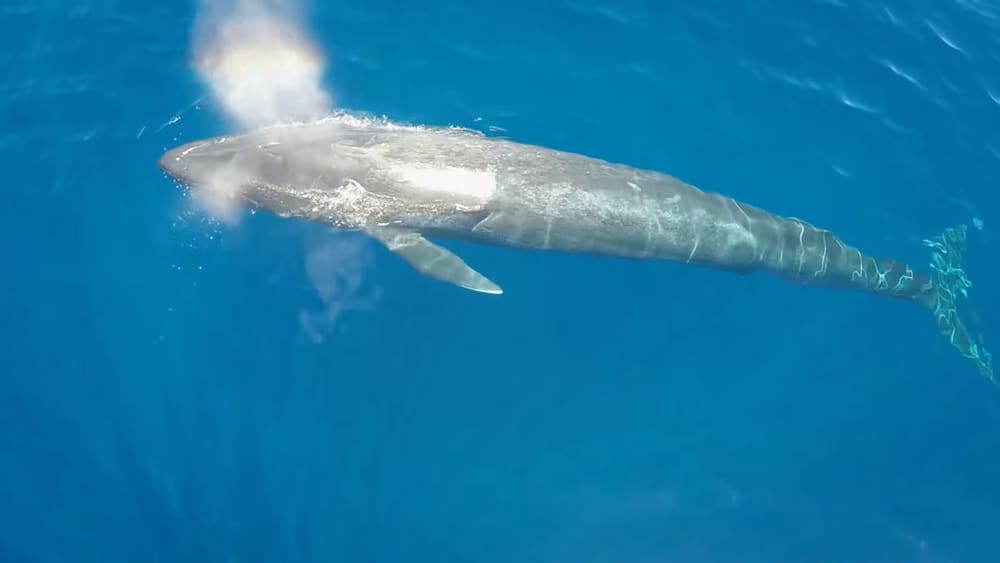
Blue whales, like all mammals, must breathe air.
They cannot extract oxygen from water and must reach the surface every few minutes.
Their paired blowholes (the evolutionary remnants of nostrils) sit on top of the head, right in front of the eyes.
When a whale surfaces, it forcefully exhales warm, moist air that instantly condenses in the cooler atmosphere, creating the familiar “blow” or spout; contrary to popular belief, this is mostly air, not seawater.
Blue whales typically hold their breath for 5–15 minutes, with exceptional dives rarely exceeding 30 minutes.
Each blowhole can open to roughly the diameter of a large dinner plate, about 20 cm, large enough to fit a human head.
6. Blue Whale milk’s texture is like toothpaste.
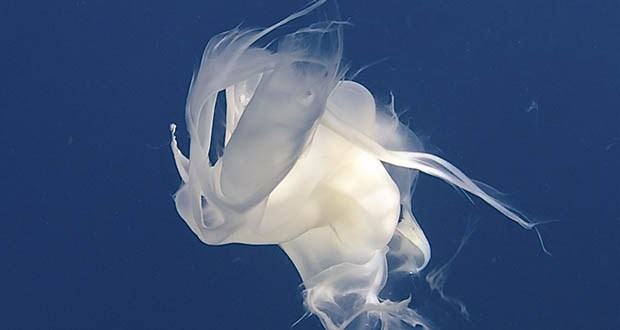
Blue whale mothers nurse their calves just as all mammals do.
Because the calf cannot yet hunt, the mother actively ejects milk through a mammary slit; the calf forms a tight seal with its tongue so the nutrient-rich stream reaches its mouth without dispersing in the water.
With 35–50 % fat, the milk has the consistency of toothpaste or soft butter, thick enough to stay cohesive for the few seconds it spends underwater.
Each day, a rapidly growing calf drinks about 220–230 litres (≈ 60 US gallons) of this high-calorie milk, gaining up to 90 kg (200 lb) in a single day during its first months of life.
5. Blue Whales’ life expectancy is more than 80-90 years in the wild.
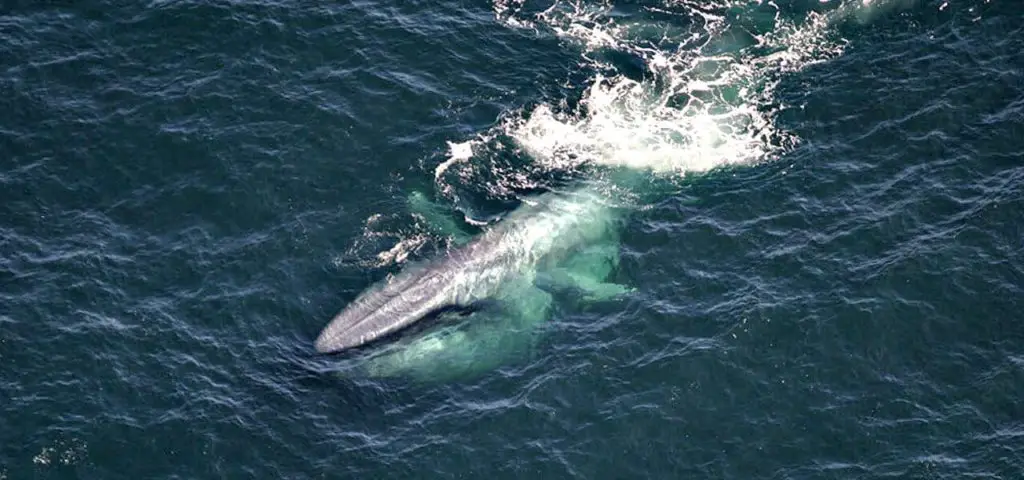
Blue whales rank among the longest-lived mammals in the ocean.
In the wild, their average lifespan is 80–90 years, and the oldest documented individual reached at least 110 years, determined from annual growth layers in its earplug.
Longevity, however, depends on a suite of threats that intensify after sexual maturity: commercial whaling (historical and any ongoing illegal takes), ship strikes, entanglement in fishing gear, fluctuations in krill abundance driven by climate change, chemical and noise pollution, and chronic injuries, all of which can shorten an otherwise century-scale life.
4. Blue whales are not actually blue

Yes, Blue Whale is not blue colored, but they appear blue. How can that be?
Well, when viewed underwater, they appear solid blue. Their actual color is mottled gray, and we can see it when they are taken out of water.
The blue color, however, is only on the upper side of their massive body.
A blue whale’s underbelly has a yellowish hue color. This hue, however, is mainly because of millions of microbes living on their skin.
3. Their voice is really very loud
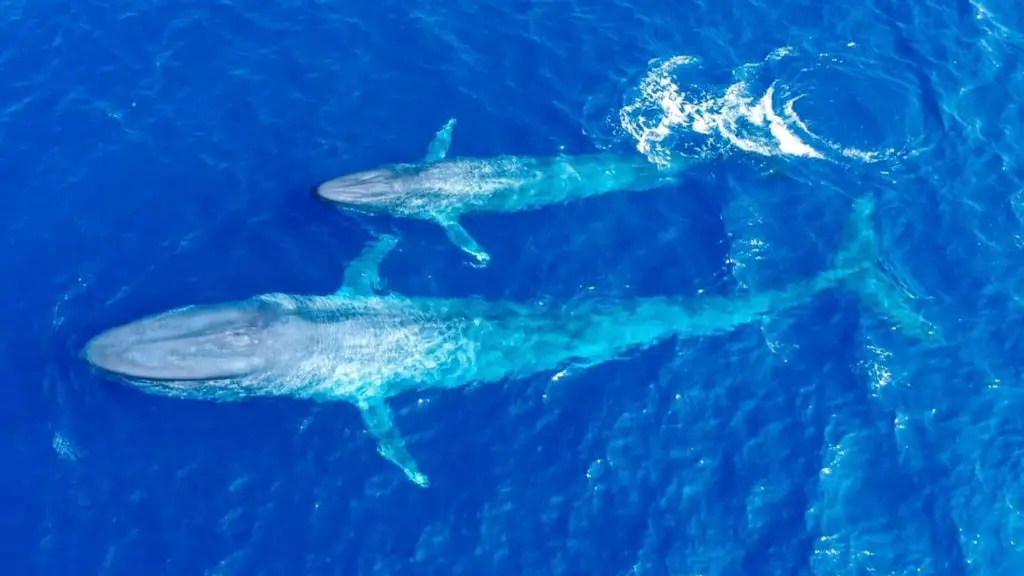
Blue whales are not only the largest animals on Earth but also the loudest, producing calls that peak at 188 decibels, which is louder than a jet engine at take-off.
Their low-frequency moans, groans, and pulses can travel hundreds to more than a thousand kilometres when refracted through the ocean’s deep-sound (SOFAR) channel.
These vocalizations are used to communicate, find mates, coordinate migrations, and maintain contact across ocean basins.
Although blue whales have excellent hearing and can exploit underwater acoustic “reflections” to orient in dark waters, they do not echolocate; that specialized biological sonar is restricted to toothed whales such as dolphins and sperm whales.
2. Blue whales can increase their speed up to 31 mph
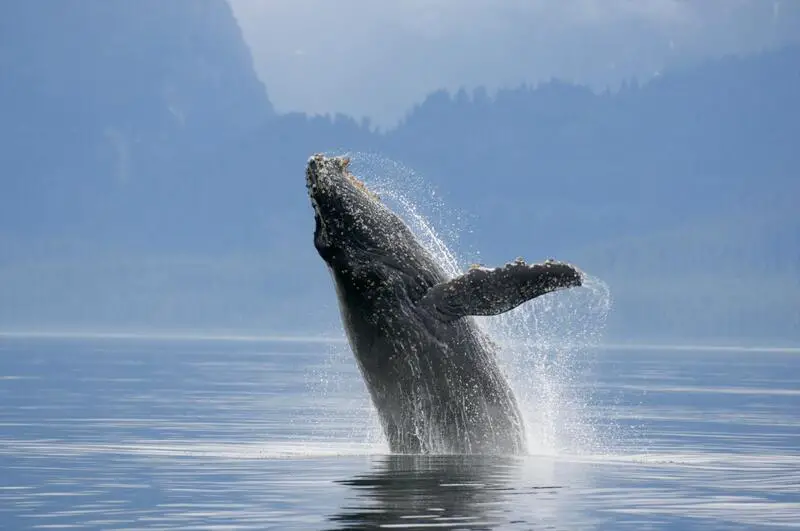
Blue whale habitat is worldwide, but they follow regular seasonal patterns.
They enjoy summers feeding in cold waters of polar regions and make a long trip back to equatorial regions of the Indian ocean as winter comes along.
This seasonal migration is because krill move towards warmer waters in winter.
Traveling a long-distance like this with their massive body is not an easy task & requires speed.
Blue whales can reach speeds of up to 50 km/h (31 mph) in short bursts, usually when interacting with other whales or reacting to threats.
Their more typical travel speed is around 20 km/h (12 mph), and they slow down even further, closer to 5 km/h (3 mph), when feeding or cruising leisurely through the ocean.
The high-speed bursts are rare and not sustainable for long periods, given their immense size and energy requirements.
1. Conservation status

We, humans, are insignificant, and for our pure appeasement, we can ruin anything.
Why are blue whales endangered?
By the first half of the 20th century, Blue Whales were almost on the brink of extinction because we killed them at large scale.
About 360,000 of these beautiful creatures were killed by us.
Why have they been slaughtered?
Just because of whale oil. This whale oil as valuable and have many medicinal properties.
In 1996, The International Whaling Commission stepped forward to protect these creatures.
As of today, here are only 4,500 (or less) Blue Whales remaining on this entire planet.
Whales like sperm whales, humpback whale, killer whales, and blue whales are endangered not just because of hunting, there are various reasons like,
Increasing ocean pollution because of human behavior threatens their existence.
They also die for oil spills (from oil tankers), changes in environmental conditions (which is again mainly caused by human activity), high ocean traffic, and ship strikes, they often collide with big ships and end up dead.
Of natural food-chain, Blue Whales are very important for the balance of the oceanic ecosystem and have equal rights, as we humans have to live on this planet.
These were some amazing facts about the blue whale for kids.
If you really want them to survive, share this post on your social media & make sure your friends know about the information.
Create awareness & compassion to save these helpless animals🐋.
FAQs
What size is blue whale heart
The blue whale’s heart is the largest of any animal and can weigh over 400 pounds (180-200 kg), though some estimates put it as high as 900 kg in exceptional individuals. In terms of size, it is about as big as a golf cart or go-kart, approximately 5 feet (1.5 meters) tall and 4-5 feet (1.2-1.5 meters) wide and high. The blue whale’s aorta is so large that a small child could crawl through it.
How much does a blue whale weigh
An adult blue whale typically weighs between 100 to 150 tons (90,000 to 136,000 kilograms), with the largest recorded individuals reaching up to 199 tons (180,000 kg to 200,000 kg or more). Most adults found in the wild weigh in the range of 72 to 135 tons, but exceptionally large individuals may exceed these values. Blue whales are by far the heaviest and largest animals ever known to have existed.
How big is a blue whale
A blue whale is truly massive—the largest animal on Earth. Adult blue whales typically reach lengths of 80 to 100 feet (24 to 30 meters), though the longest confirmed individual measured about 98 feet (29.9 meters). Exceptional cases may reach up to 108 feet (33 meters) according to some reports, but most adults are observed in the 70-90 foot (21-27 meter) range.
In terms of height, their bodies are typically 13-16 feet (4-5 meters) tall. The average weight ranges from 55 to 165 tons (50,000 to 150,000 kg), with some of the biggest individuals weighing up to 199 tons (180,000 kg). Females are usually larger than males.
Newborn blue whales are also huge, with calves measuring about 23 feet (7 meters) long and weighing 5,000 to 6,000 pounds (2,300 to 2,700 kg) at birth.How long is a blue whale
Blue whales typically reach lengths of 80 to 100 feet (24 to 30 meters) on average, with some individuals confirmed up to 98 feet (29.9 meters). The largest recorded blue whale was measured at 110 feet (33.5 meters), though such lengths are rare and most adults fall in the 70–90 foot (21–27 meter) range.
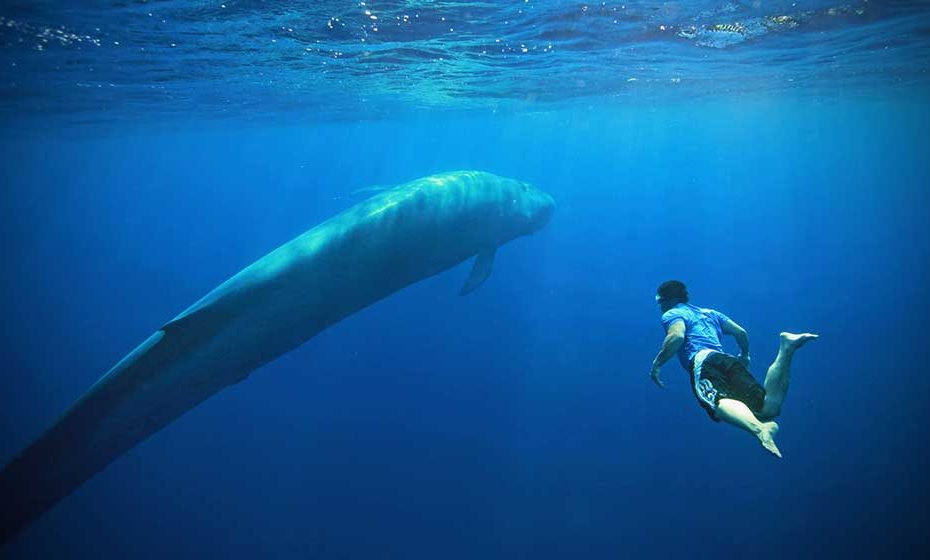
Blue Whales are amazing creatures…save them
I’m very happy that I came across this in my ѕearch for something concerning
this.
The aquatic life has always been a joy for me to explore. It is amazing how water holds this much.